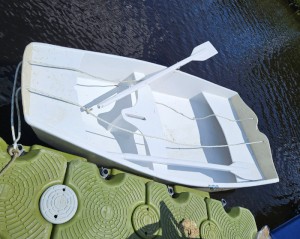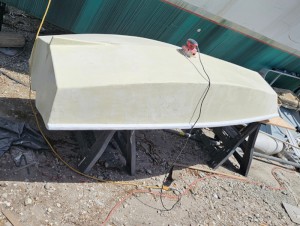Kaimusailing
s/v Kaimu Wharram Catamaran
| Vessel Name: | Kaimu |
| Vessel Make/Model: | Wharram Custom |
| Hailing Port: | Norwalk, CT |
| Crew: | Andy and the Kaimu Crew |
| About: | Sailors in the Baltimore, Annapolis, DC area. |
23 April 2024 | St Marys, GA
D4 Launchie
The laptop pooped the bed, so I have to scurry around with alternatives. Not as bad as typing on the phone.
17 April 2024 | St Marys, GA
Dinghy Skeg
I was suffering with what seemed like a cold and also had allergy symptoms. I awoke and felt fine. The green pollen that was coating everything was gone. Maybe it will return.
07 April 2024 | St. Marys, GA
Clammy Hands
Items came in from TEMU, the Chinese cut rate retailer. One was a nice little drone that cost about twelve and a half dollars. It looked like an easy thing to play with while I coughed and sneezed. I was fighting a summer cold, even though it is not summer elsewhere, it seems like it here. A nice [...]
02 April 2024 | St. Marys, GA
Sun Doggie
After laminating the cedar strips onto the gunwales of the dinghy I found the screws I used wouldn’t come out. The epoxy had seized them. The screw heads were stripped so I cut a straight slot in the heads with the cut off wheel. The cedar smoked when the screw heads got red hot. I could remove [...]
21 March 2024 | St. Marys, GA
Just Add Water
The rainy weekend started off with overcast and fog but no rain. It looked like I might be able to get something done on the D4 dinghy. I wanted to change the bow seat which is really the bow deck. The sailing option uses the deck to hold the freestanding mast. I didn’t like how the deck looked, [...]
01 March 2024 | St. Marys, GA
D4 Dinghy Alternative Seats
The rain event was more wind than rain, strong winds with gusts up to 44 mph. We drove into town to see what the harbor was like. There was a small sailboat that had dragged anchor and was sitting close to shore. The tide was out. We left and played with Bleu at Notter’s Pond.
2 Weeks to Launch

.
The autopilot is an Auto Helm AH3000 wheel pilot. This is an old unit, but seems almost bulletproof. The firm was bought out and the ST3000 wheel pilot is the direct descendant, almost a direct clone of the AH3000. Added features in the more modern units include NMEA interface, wind vane option, remote control, but I would not use any of those. I have no NMEA devices on board. No wind instruments except a hand held meter and the Windex wind vane on the head of the mast. There are some robust wheel pilots currently available and I guess I will be getting one of those some day.
.
The pilothouse was complete after cleaning up the corner where all the tools were, and taking those tools out of the pilothouse. I will try to bring only navigation instruments and engine related supplies into the pilothouse.
.
The next project is to square away the dinette, and then do the galley, again. Too many tools, and too many objects deposited in both places that do not belong there. Pajamas, rain gear, broken computers, cameras, hand held radios, hand held GPS’s. There’s more stuff in the earlier archeological strata down near the galley counter’s surface, which has rarely been seen.
.
I'm planning to start using the portable propane stove top in the galley. It fits right over the alcohol stove and is superior in that control of the flame and heat is possible, and propane does a better job of heating than alcohol does. The drawback is the explosive nature of propane, if the gas leaks out of the system. It’s heavier than air, so it collects at the lowest point, in the bilge, and then a spark will set it off. Many yachts have blown apart from propane leakage. I had used this stove before for quite a while. My cast iron cookware needs a hot stove to function properly, the alcohol stove just isn’t up to the job.
.
My neglected cast iron pans were rusty and looked like they should be thrown out. Then I remembered the big wire brush/grinder in the woodshop. I had used it to clean bolt threads and the last thing I had used it for was wire brushing a cheap Harbor Freight ratcheting right angle screwdriver that didn’t ratchet any more. After brushing it free of corrosion and oiling it, and exercising it, it began clicking away like brand new. It even looked new.
.
So, I brought my 3 cast iron skillets to the woodshop and wirebrushed them inside and out. Then I put them on the electric burner in the communal kitchen, one at a time, let them come up to full temperature, then oiled them with olive oil and allowed them to cool.
.
I used the largest pan to make a shrimp pasta recipe which consisted of ingredients that were getting old and had to be used or thrown away. Maybe I could fry up some steaks...
.
The next day turned into a real scorcher, not as forecast. Our thermometer in the shade hit 101. Some items came in, though, and I got to work before the heat index soared later in the day.
.
The circuit breaker for the windlass came in. It didn’t have the same footprint as the original, but was smaller, so I installed it on the backplate of the original and mounted it in its original location. After hooking up the cables to it, the windlass was tested and it hauled in the loose chain on deck.
.
While looking for screws for the circuit breaker I came across a treasure trove, 3/16“ diameter stainless steel pop rivets with a good 5/8“ reach, perfect for reconnecting the boom to the gooseneck after I drill the old rivets out and rip it all apart. I had ordered a batch from Albany County Fasteners in New Jersey, but they won’t arrive for a couple of days.
.
I drilled out the old rivets. I used a 3/16“ drill, but then needed a larger drill to remove the rivet heads. It went very quickly, the old rivets were aluminum. The 3/16“ stainless would be much stronger. I punched the remains of the rivets into the boom using a long thin bolt which ended up collapsing, then I used an old tang of a file.
.
The pressure of all the attachments to the boom and sail cover forced the boom toward the mast, so it was hard to move the boom backward. I rigged a line to the boom near its end and looped it around the rear crosstube, then hauled it in on a winch on the mast. So, the line went from the end of the boom all the way aft to the rear crosstube, then went forward to the mast. Using this line and a pry bar the boom was separated from the gooseneck. I could now work inside the boom to recover the outhaul line.
.
What to do, the original problem was that I pulled on the outhaul at the clew end of the boom to get enough line to tie off on the clew car on the boom. That’s when the other end of the outhaul was drawn into the boom near the mast, at the tack.
.
The Z-Spar outhaul is not a direct line from one end of the boom to the other, the line at the end that tensions the clew of the sail is coming from a purchase, maybe 5:1, located inside the boom. The end of the outhaul that we actually work with comes out of the boom at the gooseneck. It has a 5:1 power ratio so that when you pull in 5 feet of outhaul, the actual outhaul only goes 1 foot.
.
When I was organizing the end of the boom and pulled on the outhaul, I was working from the other end of the 5:1 ratio, when I pulled in a couple feet of line, the result was 10 feet of line going into the boom at the mast.
.
So I had pulled all of the working end of the outhaul into the boom, that is why I had to open up the boom, retrieve the outhaul line, then put the boom back together.
.
The 3/16 diameter blind rivets did the job for the most part, but a couple of the old rivets ended up needing 1/4 inch rivets, which I ordered. For now, the 3/16 rivets would hold the boom until I put in the two 1/4 inch rivets. The big nerve wracking boom project was complete.
.
Working on deck was brutal. I used the hockey system, I worked for a while until I found I was forgetful or feeling not up to par, then took a break of about 15 minutes. When you take such a break it might seem like you are OK after just a few minutes, don’t go back to work just yet, take the full 15.
.
It is very hard to stop working when you get to the final stages, but it is best to take that break, your work will be better, and your mind will be sharper.
.
The result of pushing work in the oppressive heat, even though taking long breaks, is that the mind is numb, the body fatigued, but progress has been made. The energy that propels me into this state comes from the agenda of work that needs to be done, and the countdown that continues, two weeks to launch day.
.
The image is from saatchiart.com, it is by Stacie Schimke of the USA. It is a large work, maybe 4 feet square. It is called Voltaic 2. The artist quote: "I painted a series on climate change because I was inspired to express my feelings on the subject and to try to bring more awareness to the problems global warming is causing.” Hey, global warming, what about warming in St. Marys, GA, ?
.
Another link is to Bruce Creations at:
.
https://www.youtube.com/channel/UCHurQgF9M7rkXZXHkQtD0EQ
.
This fellow crafts carbon fiber with amazing technique.






